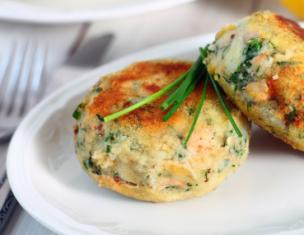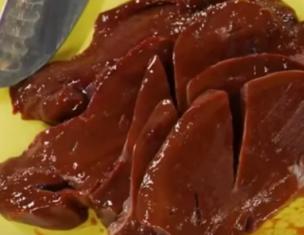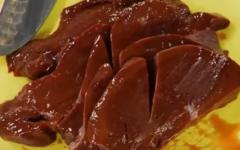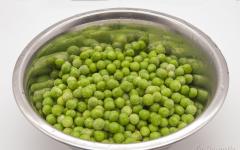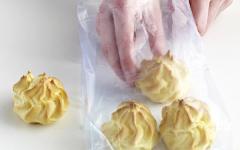Even in distant Medieval Europe, high-ranking people appreciated dishes from by-products. Often they were called delicacies. The original soup of the language was also considered exquisite and unusual.
After a century, scientists unanimously declare that all the broths from this by-product, whether it's fish soup from the sea language or the first dish cooked on the basis of pig tongue, have a mass of unique properties. In addition to the fact that these dishes are very hearty and tasty, they are also surprisingly useful. The language contains many micronutrients, such as magnesium, iron, potassium, copper, calcium, cobalt. In addition, it also contains vitamins - PP, B 1, B 6, B 2. And of course the soups are always easy to digest, they only affect the gastrointestinal tract and help to cope with the various ailments of this body. So, how to cook soup on broth from tongue (pork, sea)?
This soup is prepared very quickly, but at the same time it has a rich taste and a huge list of useful properties. And the variety of colors in this dish will necessarily improve your mood.
Ingredients:
Preparation:
1. Cook the tongue. The broth obtained after cooking is filtered through a sieve and, pouring it into a saucepan, bring to a boil.
2. While the broth is boiling, you need to peel the potatoes and cut it into strips or cubes. Once the broth begins to boil, throw in the cooked potatoes, which is recommended to cook for no more than 10 minutes.
3. Carrots should also be cleaned and cut into cubes or circles. It is desirable to throw carrots into broth at the same time as potatoes. However, some housewives prefer to put out the carrots with onion. Then the roast can be added to the soup for a few minutes before its final readiness.
4. If the onion you do not like to fry, cut it into small cubes or thin semirings and dip it into the broth a few minutes after cooking the potatoes.
5. Along with onions in soup from beef tongue drops cut into small pieces of cabbage and chopped garlic.
6. The taste of the hostess is added to the almost prepared dish greens and spices. If the tongue is cooked in salt water, it is not necessary to add salt to the soup.
7. When all the ingredients are already in the saucepan, you need to give the soup to puff for 7-9 minutes and you can turn it off. If the family likes soups with meat, previously cooked tongue can be cut into thin strips and put into a ready dish before serving directly on the table.
Not less popular with gourmets is a simple soup made of marine language, which is often called transparent.
Ingredients:
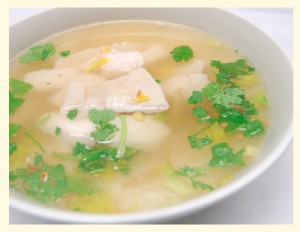
Preparation:
2. At this time, it is possible to dip the onion and carrots cut into large pieces into the broth.
3. While cooking vegetables, it is recommended to prepare noodles. It is not needed in a large number, t. The noodles have properties to be boiled and swelled. Therefore, a small handful of vermicelli is quite capable of making the soup of the sea tongue nourishing and tasty.
4. Cook the soup until the vegetables are ready. Then in this transparent broth the tongue falls and the greens are crumbled.
Delicious useful and original soup is ready!
And what kind of mistress does not dream of making her delicious mushroom soup in the language ?! Next, the recipe for this first dish will be presented.
Ingredients:
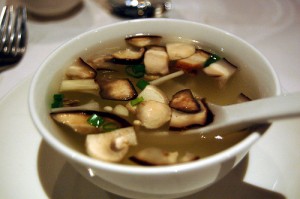
Preparation:
1.Language is cooked until ready, cleaned and cut into small cubes or straws.
2. Mushrooms are stewed in vegetable oil, after which they are washed in cold water. Ready mushrooms drop into the broth.
3. Add to the soup from the tongue of pork or beef rice, which can be cooked for 10-15 minutes. For soups, long grain rice, which does not boil and does not swell.
- beef tongue - 200-250 g;
- sour cream - 300 ml;
- flour - 3 tbsp. l .;
- chili pepper - 1 pod;
- lemon juice - 1 tbsp. l .;
- garlic - 1 head;
- fresh parsley - 3 sprigs;
- dill - 3 branches;
- olive oil;
- salt to taste;
- black ground pepper to taste;
Cooking method
- Before preparing this hot soup, let's boil the beef tongue. To do this, bring the water to a boil and drop the pre-washed meat there for 15 minutes.
- Pour out the water, the tongue is rinsed again, we remove the outer film and cut it in half.
- Pour into a saucepan 3 liters of water and cook beef for two hours.
- When the meat is ready, take it out, let it cool down, then cut it with strips.
- The remaining beef broth filter so that it is not too greasy, then put it back on the fire, and after boiling we remove it.
- Using a mixer, mix egg yolks with sour cream and flour. In the resulting mixture, pour a glass of cooked broth, mix again and pour the mass into the soup.
- Immediately throw the pieces of tongue in a saucepan, salt with pepper and cook for another 3 minutes on a small fire.
- We prepare the gas station. Grind into a separate bowl of purified garlic, slightly salt and add crushed, pre-cleaned from all partitions, chili pepper. Ingredients mix well.
- Before serving, fill the ready soup with the garlic mixture obtained, decorate with chopped dill and parsley and add lemon juice. Bon appetit, dear readers!

If you want to believe it, you do not want it, but in France, about 500 years ago, a royal decree to peasants was strictly forbidden to take your tongues when slaughtering cattle. Where and how everything else is used is a separate topic. But only the faces of the noble class had the right to taste tongues. We, thank God, not in medieval France. Therefore, we have every right to enjoy this really delicious product. Moreover, in the course you can safely not only the language itself, but also cook delicious broth.
Ingredients for cooking broth from the tongue:
- Beef tongue 1 piece
- Butter 20 grams
- Pepper and salt to taste
- Water 3-5 liters
- Greens to taste
Do not fit the products? Choose a similar recipe from others!
Inventory:
- Pan
- Pan
- Plate
Preparation of broth from the tongue:
Step 1: Preparing the language.
First of all, it must be rinsed well. And one more important detail. It is better to use the language chilled instead of frozen. Frozen gets a specific taste, and the broth will be more cloudy. Was it washed? Now put it in a pot of boiling water. It is not necessary to cook for a long time, it is enough just to test it. then take it out of the pan and quickly take it into cold water. It's easier to remove the skin from it. She must get off lightly, like a stocking. We pour out the water from the pan, pour a couple of liters of clean water and let it boil. Meanwhile, we will continue to study the language.Step 2: Roast the tongue.
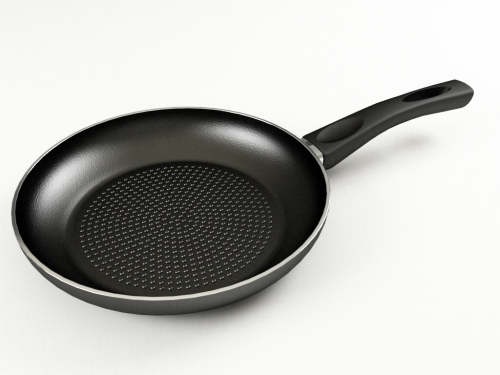 Put the frying pan on the stove, let it warm up. And not just so, but with butter. In the meantime, we'll salivate, pepper the cleaned tongue - and put it on the frying pan. Let it be fried. Boiled water in a pan? We put the fried tongue there and cook until ready. How long? Long. And an hour, and a half, and two. The main thing is to be ready. Doubt? And you fork it. Comes into the pulp? So, it's ready.
Put the frying pan on the stove, let it warm up. And not just so, but with butter. In the meantime, we'll salivate, pepper the cleaned tongue - and put it on the frying pan. Let it be fried. Boiled water in a pan? We put the fried tongue there and cook until ready. How long? Long. And an hour, and a half, and two. The main thing is to be ready. Doubt? And you fork it. Comes into the pulp? So, it's ready. Step 3: Filter the broth.
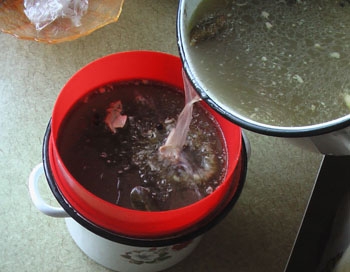 It remains a very small thing. Ready broth should be filtered, and the tongue cut into portions.
It remains a very small thing. Ready broth should be filtered, and the tongue cut into portions. Step 4: Serve on the table.
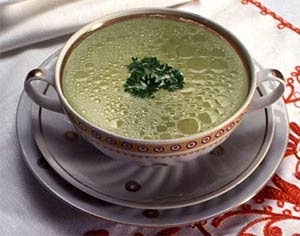 Broth is poured into plates or soup stock, we add there pieces of ready-made tongue. And then everything depends on your imagination. You can add greens, croutons, sour cream, a slice of lemon. But the broth is delicious and on its own. Bon Appetit!
Broth is poured into plates or soup stock, we add there pieces of ready-made tongue. And then everything depends on your imagination. You can add greens, croutons, sour cream, a slice of lemon. But the broth is delicious and on its own. Bon Appetit! Fresh language in its raw form is stored for no more than a day. - Boiled tongue is stored for three days.
If you bought a salty tongue, it should be thoroughly soaked for 24 hours, regularly changing the water.
A broth from the tongue is an excellent basis for making all kinds of soups
Guests often want to surprise with something unusual and very tasty, so before the arrival of guests make up the menu and buy the best products from which you can really cook something extraordinary and delicious: french cheeses, steamed veal (I would like to marble beef, but it's really painful), pork tenderloin ...
In a word, nothing is a pity for an exquisite table and for dear guests. But how often do they choose by-products for preparing culinary masterpieces? Let's put it bluntly, the internal organs and almost junk parts of the carcasses seem to many unattractive. Though here it is possible and to argue. For example, the Roman Caesar during the fall of the empire, Vitellius, was preparing a very expensive and simply a great dish "Shield of Minerva", since the emperor became famous for his gluttony. The dish was served exclusively on a huge silver plate and consisted of the following ingredients: liver parrotfish, shark milk, pheasant brains and flamingo tongues ...
And now let's look again at this list and we will be able to make sure that nothing on the huge silver shield was anything but by-products. However, all this was submitted to the emperor himself and was very expensive. Although a more expensive dish is also known, and it was also prepared from by-products - Lucius Licinius Lucullus, nicknamed Pontus, Roman commander, politician and consul 74 BC. e. remained in history not only as a politician and commander, but also as a lover of abundant and exquisite meals. And it was Lukull who liked to treat his guests with pate from nightingale tongues, which, if not cool, were also by-products. And how many nightingales had to be destroyed for this pate! Tens of thousands of birds could not sing their most beautiful song ...
So the talk that offal is a junk food and unfit for food is refuted by history itself, and the dishes from the language and in general have always been considered a delicacy, even if the language is not nightingale. So, let's take a closer look at beef tongue and its useful properties, composition, contraindications, cooking secrets. It is very likely that this subproduct is also worthy of all praise and admiration.
A few words about offal in general
When cutting any carcasses remain internal organs, as well as parts of the carcass, which are considered less valuable products - it is these parts of the carcass are called by-products.
As for the nutritional value, then the by-products are completely unequal.
Some of them are considered rather valuable and not inferior to meat, and sometimes even surpass it in the content of microelements and vitamins, while other offal have a lower nutritional value (some of them are used not for food, but for the production of animal feed). Traditionally, by-products are divided into I and II categories depending on taste characteristics and from nutritional value.
- The first category of offal includes liver, kidneys, tongues, heart, brains, beef udder, as well as beef and mutton tails (so-called meat-and-bone tails). By-products that have the maximum nutritional value include liver, kidneys, brains and beef and veal tongues.
- The second category includes all other by-products, including legs, ears, stomach and other parts of the carcass obtained during cutting.
Beef tongue
Beef or veal tongue belongs to the most valuable by-products and is even considered a delicacy product - it is well absorbed by the body, has tender taste, contains a lot of nutrients. It is known that beef tongue can normalize digestion, since this product contains a very small amount of connective tissue.
The weight of the beef tongue can range from 0.2 kg to 2.5 kg, depending on the size of the animal.
Beef tongue is one solid muscle that has a rough coat.
Attention! Beef meat is often included in protein diets.
In addition, beef tongue has been used for a long time and quite actively food industry at manufacturing various sausage products, a ham, various smoked foods and meat canned food. It is also known that meat of beef tongue is perfectly combined with many condiments.

The usefulness of beef tongue is explained by its rich chemical composition.
Of course, water in the beef tongue occupies a considerable amount - about 70%, however, water always remains the main component of all living organisms, so this is not surprising.
Proteins in the language occupy a percentage of 13%, the same amount (13%) in the beef language contains fat. However, there are very few carbohydrates in this large muscle - about 2%. Contained in the meat of beef tongue are various extractive substances, that is those substances of organic origin that pass from meat to broth in the process of cooking.
Extractive substances include, inter alia, urea, tyrosine, creatine, creatinine, leucine, taurine, xanthine, as well as inosinic acid and glutamic acid and some other substances. In addition, the beef contains vitamins, especially many B vitamins (B1, B2, B3, B6, B12) and vitamin E. As for micro and macro elements, the beef tongue contains magnesium; calcium; iron; sodium; phosphorus; copper; chromium; iodine; molybdenum; sulfur; potassium; cobalt; manganese and zinc.
Caloric content of this product (beef tongue) is relatively low - 100 g of product accounts for only about 173 kcal.
Most modern people are concerned about not only the caloric content of the product, but also the content of cholesterol in it. As for the amount of cholesterol in the beef tongue, it can be considered minimal and does not exceed the level of 150 mg per 100 grams of the product, and this makes it possible to classify beef as a list of dietary products. But still the beef tongue, which has already been cooked (for example, boiled), is somewhat caloric and contains 231 kcal per 100 g of product.
Beef tongue and its use
A total of 100 grams of beef tongue can satisfy almost a tenth (9%) of the daily need for calories, that is, in the necessary energy. The same amount completely satisfies the body's need for vitamin B12 during the day. In addition, beef language normalizes carbohydrate and fat metabolism (metabolism).
The same one hundredgram portion of beef tongue provides 40% of the daily requirement of the body in zinc.
It is known that if there is a beef tongue in the menu, the cholesterol level decreases, while the skin gets additional opportunities for regeneration and renewal.
Zinc, which is contained in beef, promotes faster and better wound healing and improves the overall skin condition.
A very impressive amount of B vitamins in the beef tongue positively affects the condition of not only the skin, but also the hair, which become more alive, silky and shiny.
Vitamin PP (or B3) provides invaluable help to people who are suffering from insomnia and / or migraines.
Boiled beef tongue is recommended for people with diseases of the gastrointestinal tract, including in the presence of peptic ulcer of the stomach and / or duodenum, since this product is practically devoid of connective tissues and its fibers are very easily digested, without provoking the beginning of putrefactive processes in the intestine.
Attention! The use of boiled beef tongue significantly reduces the risk of the onset and development of cancer, in particular, rectal cancer.
It is very important that beef tongue, if used regularly, helps strengthen the immune system. No less important is the fact that beef tongue, having in its composition a rather high content of zinc, activates the production of insulin and is therefore useful for people with diabetes.
Among other things, the regular inclusion of beef tongue in the menu maintains the necessary level of vitamin and mineral balance.
Contraindications for the use of beef tongue
Like any product, beef tongue has some contraindications, which should be taken into account when choosing this by-product.
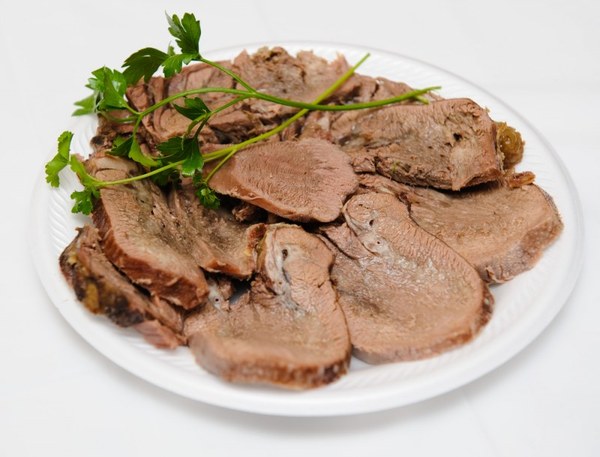
As for any other product, beef tongue is also characterized by individual intolerance, that is, when this product is categorically not tolerated by someone's body. However, such intolerance is extremely rare.
Also, beef tongue is contraindicated to those people who meat products are contraindicated in principle, although the beef tongue is digested and digested much easier than any other types of muscle tissue.
If any product, including beef tongue, is not easily digested, then there is a risk of getting an increased load on the liver and kidneys, as well as a high probability of reducing immunity. Most often, such phenomena and the inability to absorb individual foods arise in the elderly and very old people. That's why people of advanced age from eating beef tongue better still refuse.
It is very important to remove the hard shell from the tongue, so it is better to remove it almost immediately after boiling - often the heaviness in the stomach and other unpleasant symptoms arise due to the time of not removed rigid shell.
If the language seems too fat (it contains 13% of fat), then the amount of consumption of this product should be simply reduced, but it is not necessary to give it up completely.
Gastroenterologists warn that people with chronic diseases of the digestive system should eat beef tongue with extreme caution.
Attention! As a result of many studies it has been convincingly proven that the benefits of eating beef tongue far exceed the harm of this product.
Preparation of beef tongue
Meat properly cooked tongue becomes a real delicacy - it is soft and tender.
Boiled tongue
In the home kitchen beef tongue is most often boiled, then cooled and cut into portions. In addition to the portioned cut tongue, often this by-product is used for the preparation of a jellied. Sometimes soups are cooked on broth in which the tongue was cooked.
In order for the beef tongue to cook properly and be of good quality, it should be lowered into boiling water. That is, first in a saucepan of sufficient size it is necessary to collect water and bring it to a boil. When the water boils well, dip the beef tongue in boiling water and cook for five minutes. After five minutes, the tongue should be taken out of the broth, slightly cooled and removed from the tongue hard skin.
After the skin is removed from the tongue, the product is returned to boiling water and cooked until cooked over low heat.
How long does the cooking of beef tongue last? Naturally, time depends on the size and weight of the tongue, but experience shows that the cooking time of beef tongue ranges from three to four hours.
To determine if the beef tongue is cooked to its full readiness, it should be pierced with a knife: if the knife enters the meat easily and a clear broth appears on the puncture site, then the tongue has prepared.
The prepared tongue should be taken out of the pot with the broth and let it cool. Cooled and chilled tongue is cut across the fibers in thin slices and can be served as a separate dish.
In addition, the tongue sliced in small slices can be poured with the same broth in which it was cooked (before the broth should be mixed with gelatin) and put in the coldest place, for example, in the refrigerator, so that the jellied should be properly frozen. In the beef from the beef tongue, you can put a cup of boiled carrots, green parsley sprigs and lemon slices - to taste.
The filling of beef tongue is considered an easy and useful dietary dish.
Braised beef tongue
Beef tongue can not only be boiled or made from it, but it can also be put out. In order for the tongue to be brawned qualitatively, first it should be boiled for five minutes, then remove the hard skin from it. Then the tongue should be cut into portions and put in a lightly oiled saucepan, where to add cream or sour cream, as well as a little dry wine.
When the tongue is almost ready, put the spices in the saucepan - this can be the most miscellaneous pepper, cloves and bay leaf.
9 secrets of cooking beef tongue
Secret number 1. Before cooking, the tongue should be put for soaking in cold water for at least half an hour, and preferably for an hour. This is necessary in order for the language to be easier to clean from various contaminants. After the tongue is well soaked, it is necessary to scrape off the possible fat, mucus, and remnants of blood with the knife - the skin of the tongue must remain perfectly clean. After thorough scraping, the tongue should be thoroughly rinsed in running cold water.
Secret number 2. To make the tongue turned tender and juicy, it must be lowered only into boiling water. First, the water in the saucepan should be brought to a boil, and only then put the tongue there, which may have to be cut in half, because it increases in size due to the heat. When the water boils again (and the boiling stops after the tongue is placed in the pan), it is necessary to remove the resulting foam and boil the tongue for 15 minutes, after which the water must be drained. Then, in a saucepan, you need to collect clean water, put the pan back on the stove and bring the water to a boil, then put the tongue in boiling water and cook until cooked.
Secret number 3. It is impossible to determine the willingness of a tongue to the eye, since it depends not only on the weight and size of this by-product, but also on the age of the animal to which this language belonged. However, it should be borne in mind that the language is brewed from two to four hours. If when piercing with a fork or knife an absolutely clear liquid (juice) is allocated, the tongue is already ready, if the liquid is cloudy or even slightly cloudy, the cooking process should be continued until the liquid released at the puncture site is completely transparent.
Secret number 4. Salt the tongue only at the end of cooking, that is, at the end of the cooking process, otherwise the language will be tough. Then in the broth should be put a peeled carrot, bay leaf, perhaps onions, sweet pepper and pepper-peas.
Secret number 5. After the tongue is completely ready, it must be removed from the broth and put for a few minutes (three minutes) into cold water, after which the skin is much easier to remove from the tongue.
Secret number 6. Sometimes the tongue is preferred after the skin is removed from it. To salt this product in this case, the tongue, peeled off the skin, again fits into the boiling broth, and only then all seasonings are added there.
Secret number 7. All the additional ingredients (onions, carrots, greens) to put in broth should not be sliced, although cleaned, so that both the tongue and broth are more fragrant.
Secret number 8. If the broth in which the beef tongue was brewed will be used for making soup or another first course, then all the seasonings that were cooked in it should be thrown away, and for soup use new carrots, onions, other roots, bay leaves and everything else .
Attention! Boiled beef tongue can be used as an independent snack, for the preparation of a jellied, as an ingredient in salads. However, this is not all - beef tongue can be baked, fried (in batter or breadcrumbs), and stuffed.
Secret number 9.
Salad from boiled beef tongue, chinese cabbage and hard cheese.
Pork cabbage carefully nashinkovat. Boiled beef tongue cut into thin strips. Hard cheese (Parmesan or at least Dutch) is rubbed onto a large grater. Mix everything in a salad bowl and season with mayonnaise.
When preparing this salad it is very important to guess the proportions - no extra language, no extra cheese salad is better done. Although, as they say, it's a matter of taste ...
conclusions
Who said that offal is food for the poor? History confirms that both the emperors and the great generals did not miss the chance to eat something delicious, which has nothing to do with it, for example, to a tenderloin or to a collar.
Of course, the pate from the nightingale tongues is already too much, but we can surely try out a beef tongue or a salad of Peking cabbage with a boiled tongue.
How many salads can be made from this by-product? Yes, as much as there is patience and curiosity! And there will be other interesting dishes ...
Beef tongue is delicious and useful product - it is quite appropriate in any kitchen and can decorate any festive table.



